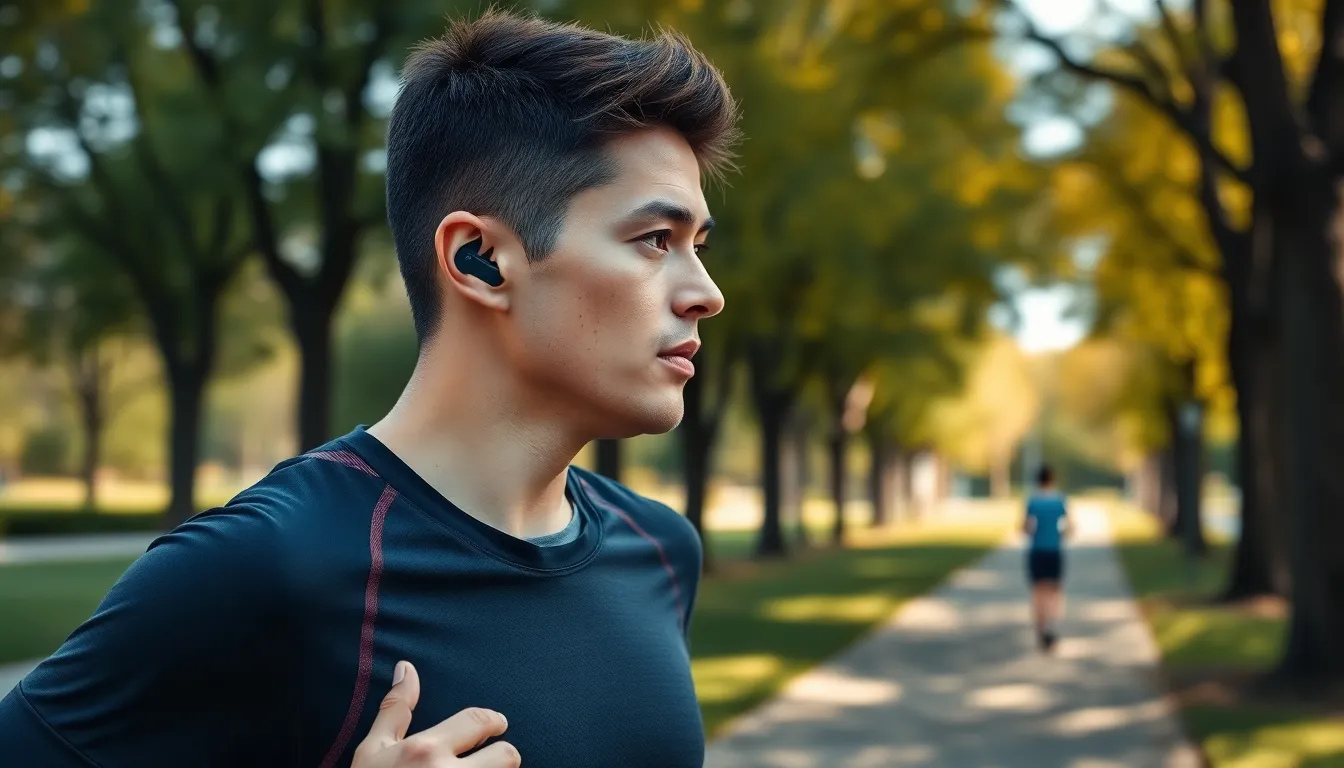Imagine a world where you can enjoy your favorite tunes while still being aware of your surroundings. Open-ear wearable audio is here to make that dream a reality. These innovative devices let music flow into your ears without blocking out the sounds of life around you. Whether it’s the sound of a friendly dog barking or that crucial announcement at the train station, you won’t miss a beat—literally!
But let’s be honest. Who needs bulky headphones when you can have sleek, stylish open-ear audio that feels like a gentle hug for your ears? It’s the perfect blend of convenience and comfort, allowing users to experience sound like never before. Say goodbye to the awkward head-bobbing and tangled wires. With open-ear audio, it’s all about the freedom to groove while staying connected to the world. So, are you ready to tune in and tune out?
Table of Contents
ToggleOverview Of Open-Ear Wearable Audio
Open-ear wearable audio technology revolutionizes the way users engage with sound. These devices integrate speakers that rest just outside the ear canal, providing a listening experience without complete sound isolation. Benefits include enhanced situational awareness, which is vital for outdoor activities like running or cycling.
Users enjoy features like Bluetooth connectivity, enabling seamless pairing with smartphones and other devices. This convenience allows for easy access to music and calls without interruption. Numerous models on the market offer water and sweat resistance, catering to active lifestyles.
Comfort remains a hallmark of open-ear designs. Lightweight materials and ergonomic shapes, like contoured temples, ensure that users can wear these devices for extended periods without discomfort. Battery life varies among models, with some offering up to 10 hours of playback on a single charge.
Sound quality has significantly improved over recent years. Manufacturers employ advanced audio technologies, such as bone conduction and open-back designs, to enhance clarity and depth. These features give users an enjoyable listening experience while retaining the ability to hear surrounding sounds.
As an alternative to traditional earbuds and headphones, open-ear wearable audio offers distinct advantages for those seeking freedom and connectivity. With a growing number of options available, consumers can choose devices that best fit their personal preferences and lifestyles.
Benefits Of Open-Ear Wearable Audio

Open-ear wearable audio delivers numerous advantages for users seeking a unique listening experience. This innovative technology enhances sound enjoyment while keeping users aware of their environment.
Enhanced Awareness
Enhanced awareness plays a crucial role in outdoor activities. Users can hear ambient sounds, such as traffic or pedestrians, while listening to music or podcasts. Situational awareness retains safety during activities like cycling or running. Open-ear devices promote communication, allowing conversations without removing the device. Users experience an immersive audio experience, combining entertainment and alertness.
Comfort And Convenience
Comfort and convenience represent key benefits of open-ear wearable audio. These devices often feature lightweight materials that make extended wear pleasant. Ergonomic designs ensure a secure fit, promoting ease during physical activities. Users appreciate the Bluetooth connectivity that allows effortless pairing with smartphones and streaming devices. Water and sweat resistance offers protection during workouts or adverse weather conditions. Battery life ranges, with some models supporting up to 10 hours of playback, ensuring enjoyment throughout the day.
Comparison With Other Audio Technologies
Open-ear wearable audio technology stands out when compared to traditional audio technologies.
Traditional Headphones
Traditional headphones cover the ears, isolating users from their environment. Noise-cancellation features often help block ambient sounds, ensuring an immersive listening experience. People using these headphones may miss important audio cues, such as sirens or approaching vehicles. Weight and bulkiness can lead to discomfort during prolonged use. Many users prefer open-ear options for their lightweight designs and enhanced situational awareness. While traditional headphones target a rich audio experience, they compromise on safety during outdoor activities.
Bone Conduction Audio
Bone conduction audio technology works by transmitting sound through the bones of the skull, bypassing the ear canal. This method allows users to maintain awareness of their surroundings while enjoying audio content. The technology is particularly beneficial for people with certain types of hearing loss or discomfort in their ears. Sound quality can vary significantly among different models, often lacking bass depth compared to open-ear devices. In contrast to traditional headphones, bone conduction provides a unique listening experience while ensuring safety during activities like running or cycling.
Popular Open-Ear Wearable Audio Devices
Numerous brands lead the open-ear wearable audio market, offering a variety of models that cater to different preferences and needs. This innovative technology has gained popularity for its unique advantages and modern designs.
Top Brands And Models
Leading brands include AfterShokz, Bose, and Apple, each providing distinctive open-ear models. AfterShokz Aeropex stands out for its excellent bone conduction technology and lightweight structure. Bose Sport Open Earbuds highlight a balanced sound profile and comfortable fit, making them ideal for active lifestyles. Apple AirPods Max, although larger, offer premium sound quality with a focus on situational awareness, allowing users to remain engaged with their surroundings. These brands and their respective models reflect a commitment to enhancing the listening experience while maintaining safety.
Key Features To Consider
When selecting open-ear audio devices, several critical features should be prioritized. Sound quality ranks high, ensuring clarity and balance during playback. Look for models with water and sweat resistance, especially for active users who enjoy exercising outdoors. Bluetooth connectivity remains essential for seamless pairing with devices. Comfort in design is vital, with ergonomic shapes that allow for long wear without discomfort. Lastly, battery life varies significantly, so models offering at least 10 hours of playback provide a practical solution for daily use.
Future Of Open-Ear Wearable Audio
Open-ear wearable audio technology is poised for significant growth and innovation. Vendors are increasingly focusing on enhancing user experience, which includes improvements in sound fidelity and design. Users can expect more versatility with expanded features such as enhanced noise control and adaptive audio settings.
Bone conduction technology continues to gain traction, providing not only awareness but also clarity for various audio types. Greater collaborations between tech companies and audio specialists can lead to breakthroughs in sound quality. Accessibility remains a focus, encouraging developers to create products catering to diverse hearing needs.
Growth in the fitness sector fuels demand for these devices, with athletes prioritizing safety and performance. Manufacturers are developing lightweight models that not only fit securely but also integrate fitness tracking capabilities. Features like built-in heart rate monitors or step counters may become widespread.
Sustainability is another emerging trend within open-ear audio. Eco-conscious consumers look for products made from recyclable materials. Companies that promote sustainable practices will likely attract more customers.
Increasing compatibility with smart home devices shows potential for the future. Users can control home assistants directly from their earbuds, streamlining daily tasks. As technology evolves, seamless integration across platforms and devices will enhance convenience.
Focus on user feedback is critical for ongoing development. Brands that actively engage with consumers can iterate on designs and features that prioritize comfort and functionality. Testing new prototypes with real users informs improvements, ensuring products meet the needs of an ever-evolving market.
Overall, open-ear wearable audio stands to redefine how users interact with sound, blending enjoyment and awareness effortlessly.
Open-ear wearable audio technology is reshaping the audio landscape by providing a unique blend of sound enjoyment and situational awareness. As users seek comfort and connectivity in their daily lives, these devices offer an appealing alternative to traditional headphones. With advancements in sound quality and design, they cater to a variety of lifestyles and preferences.
The future of open-ear audio looks promising, with innovations on the horizon that will enhance user experience. As manufacturers focus on features like fitness tracking and eco-friendly materials, consumers can expect even more versatile options. This technology not only prioritizes safety but also redefines how individuals engage with their environment while enjoying their favorite audio content.









